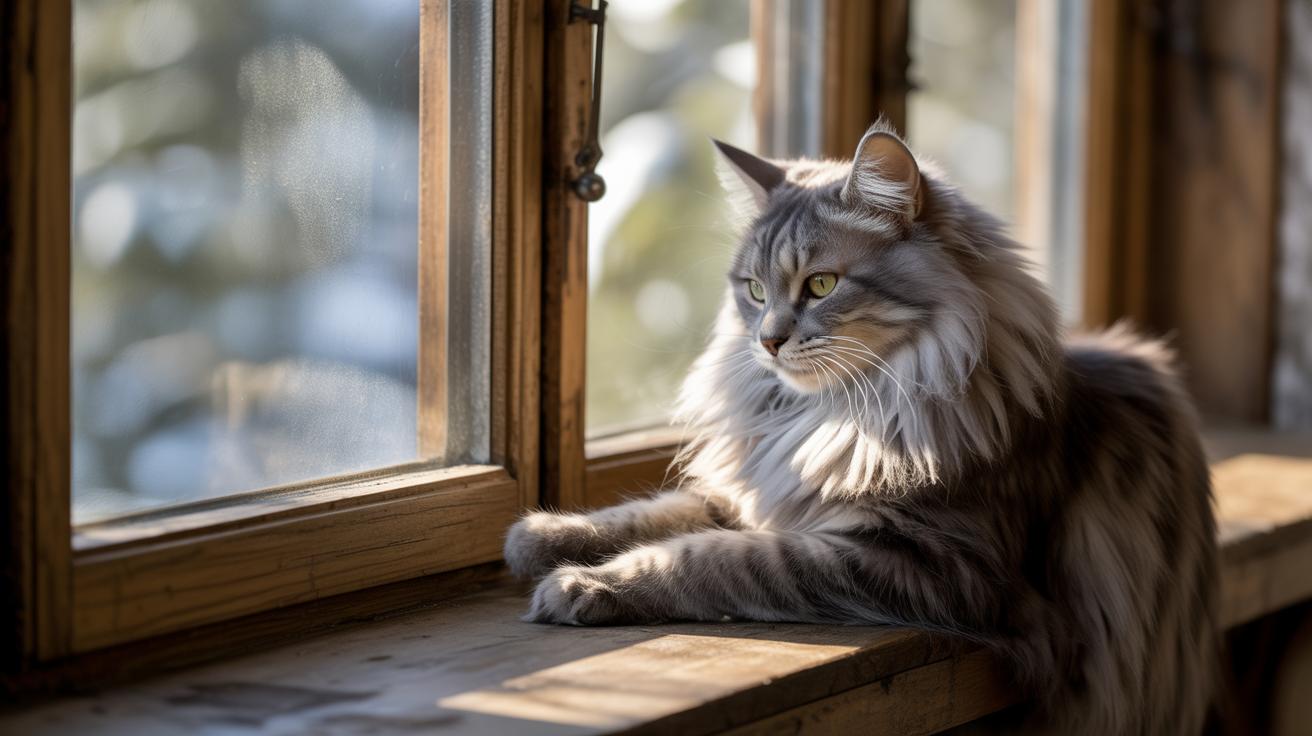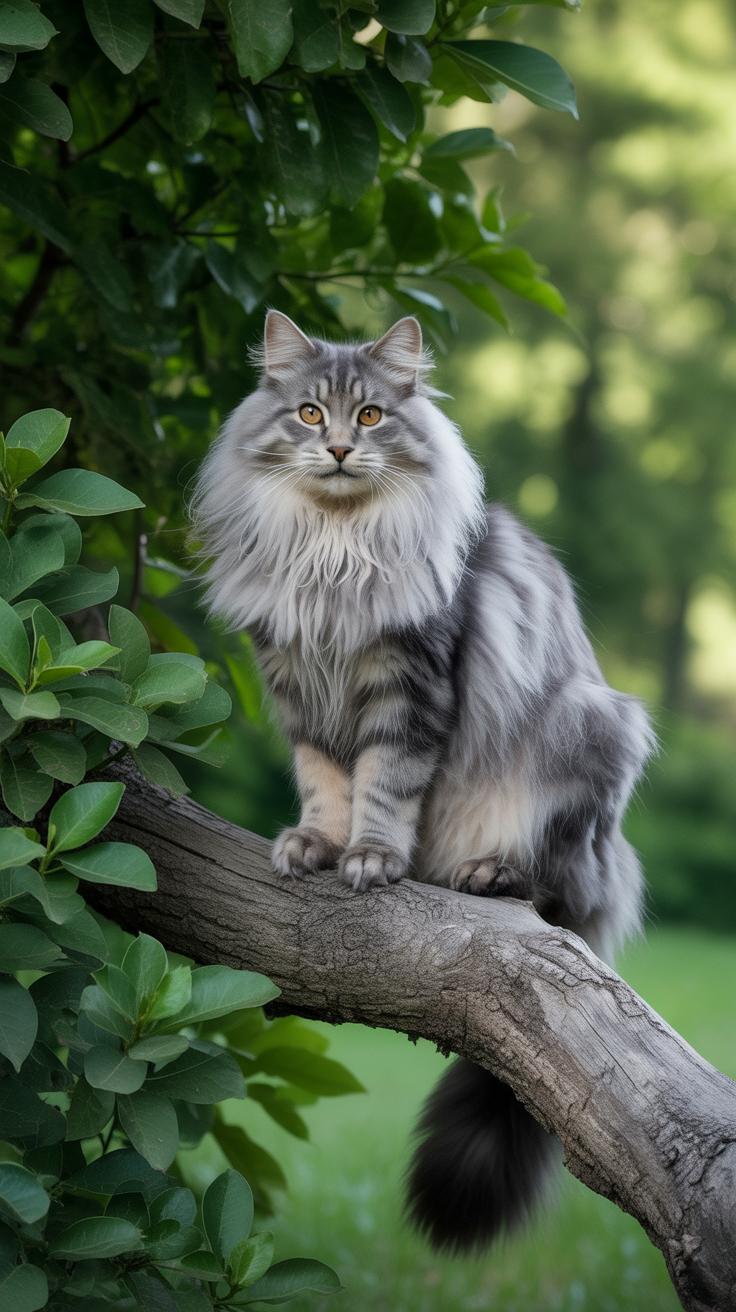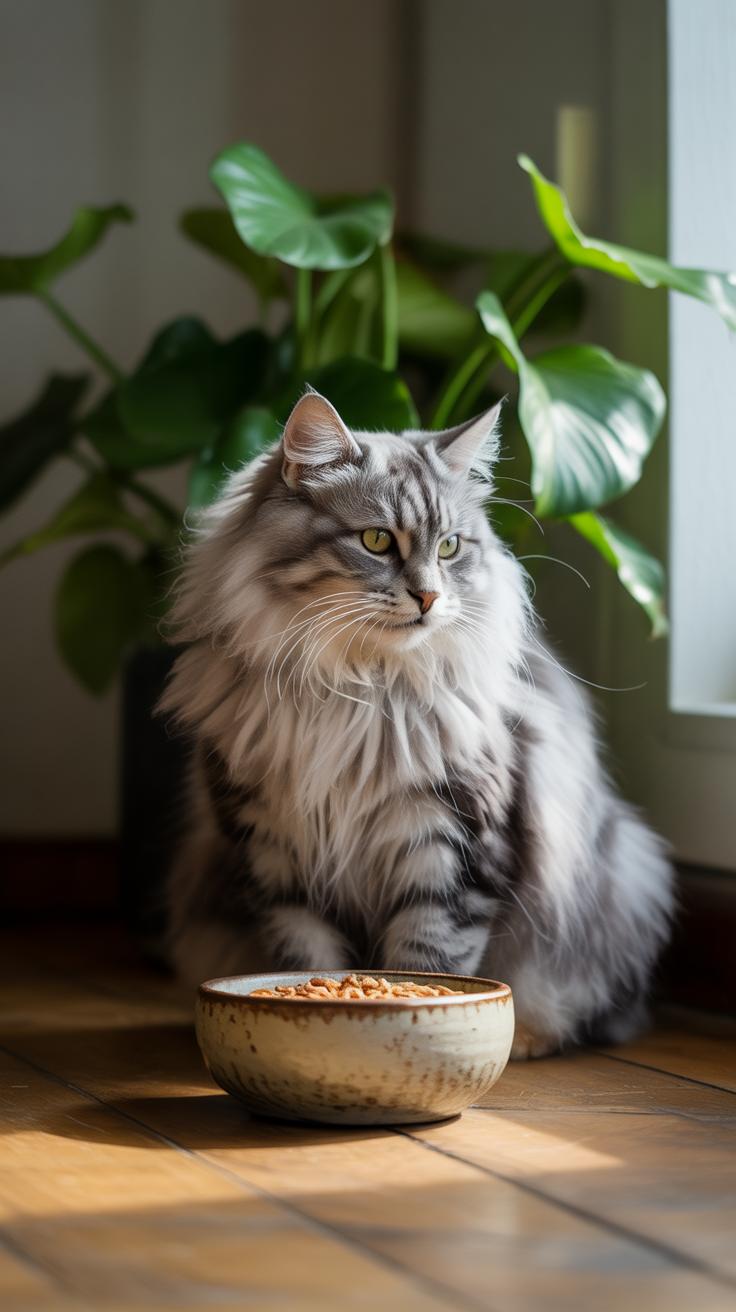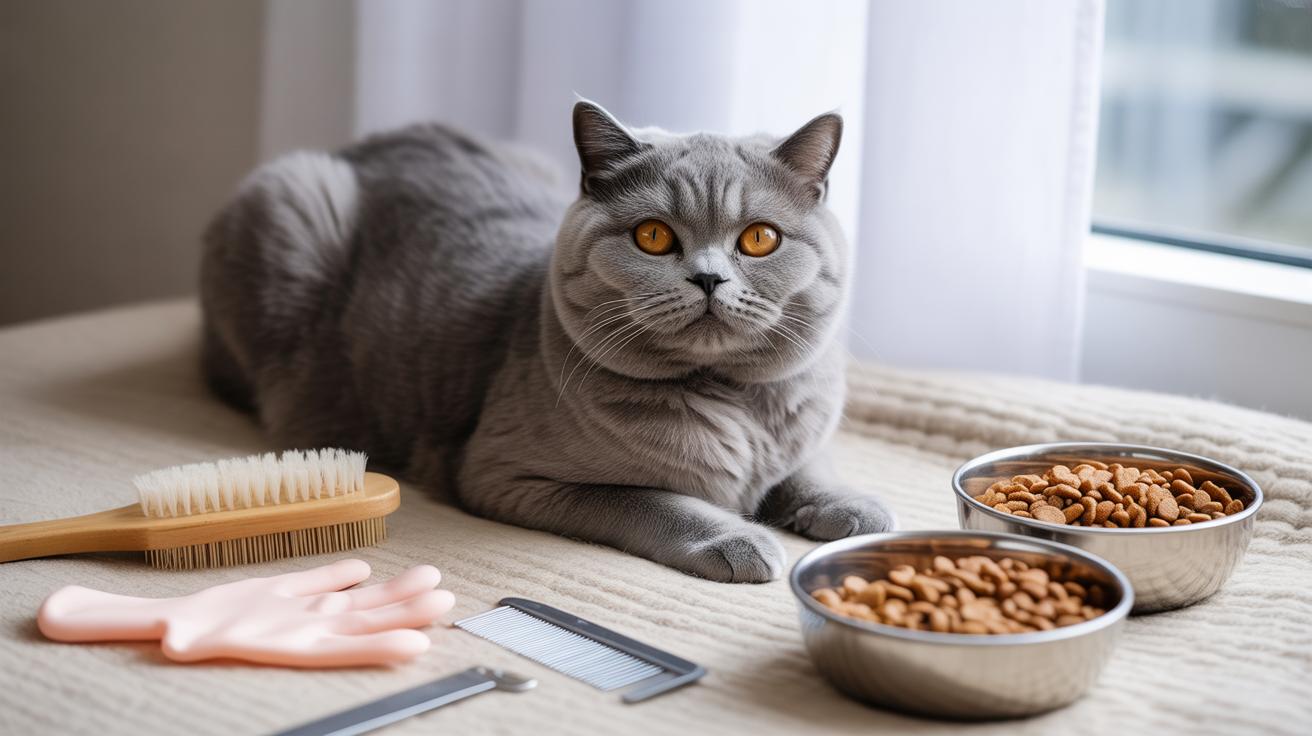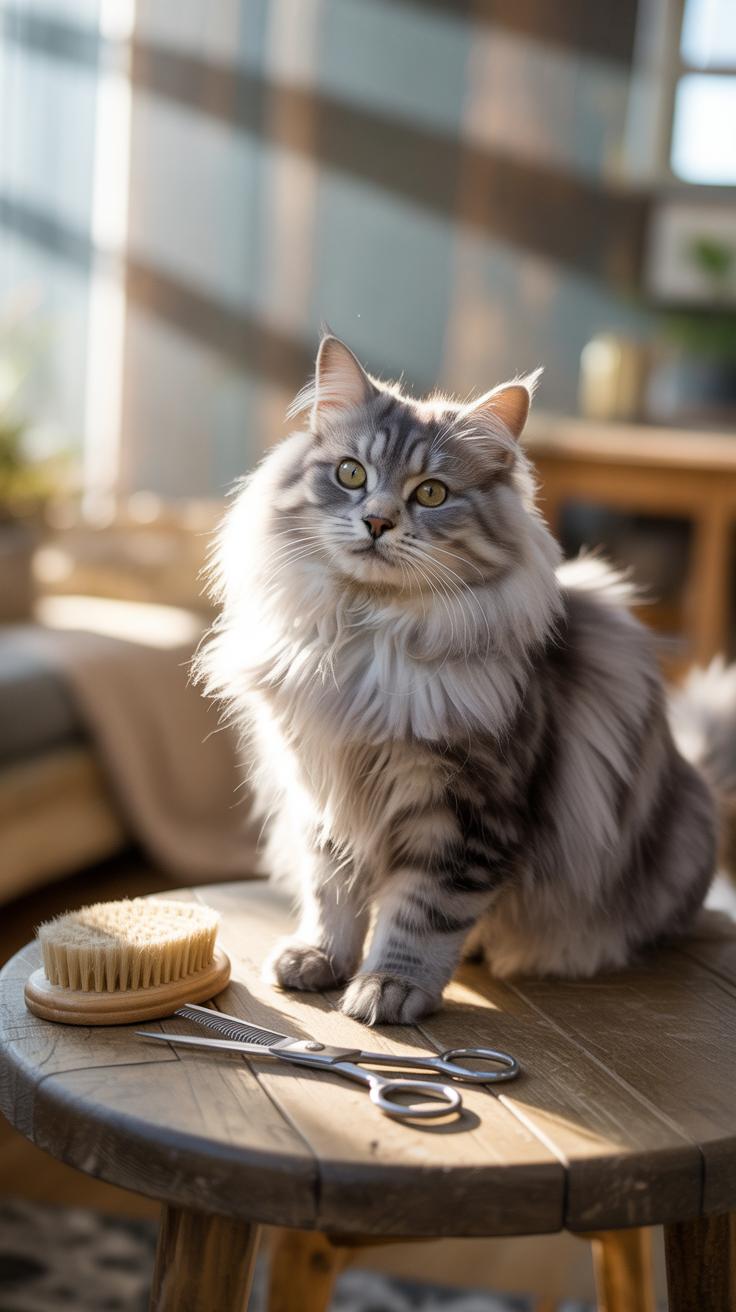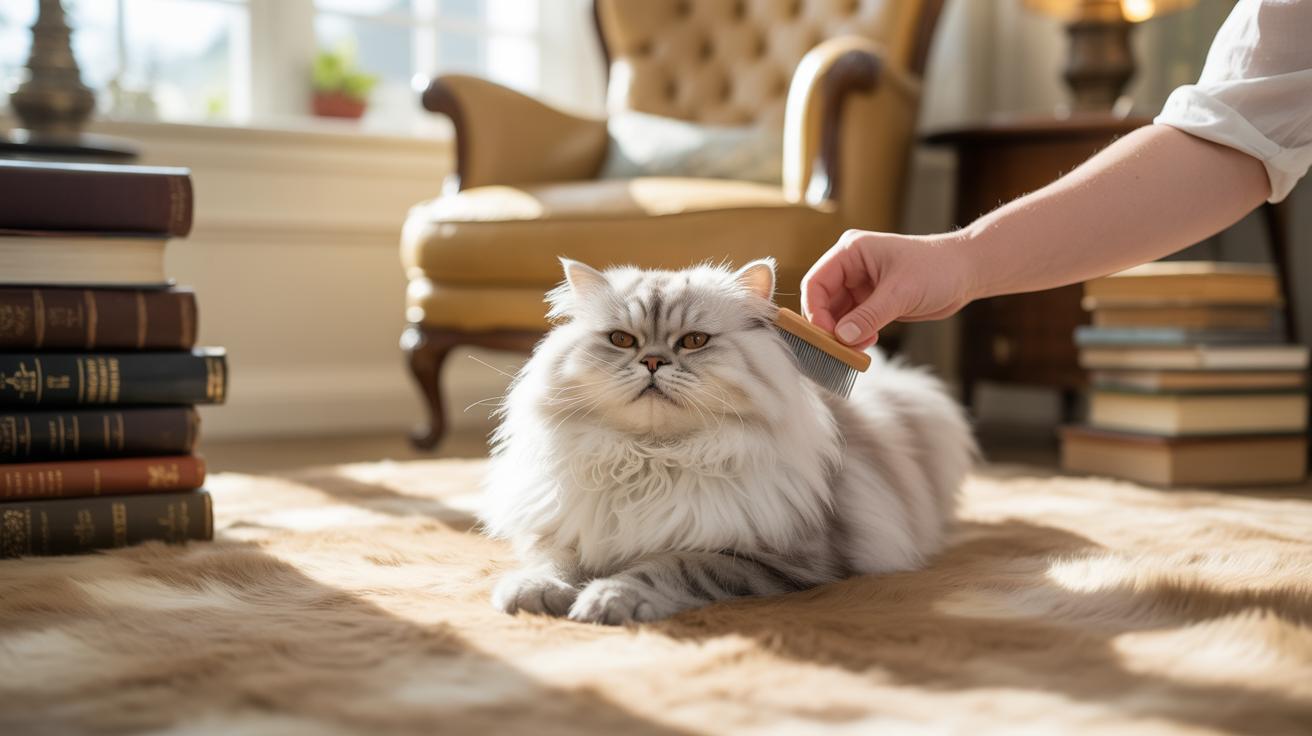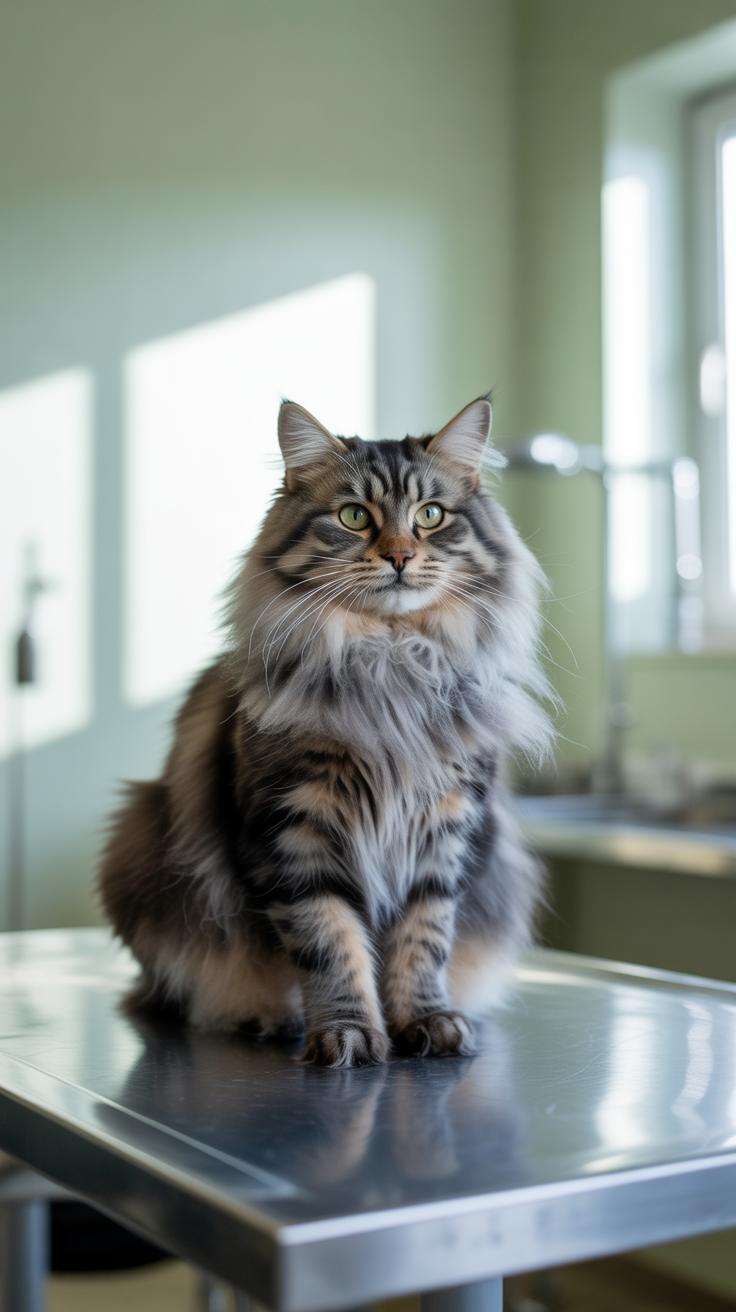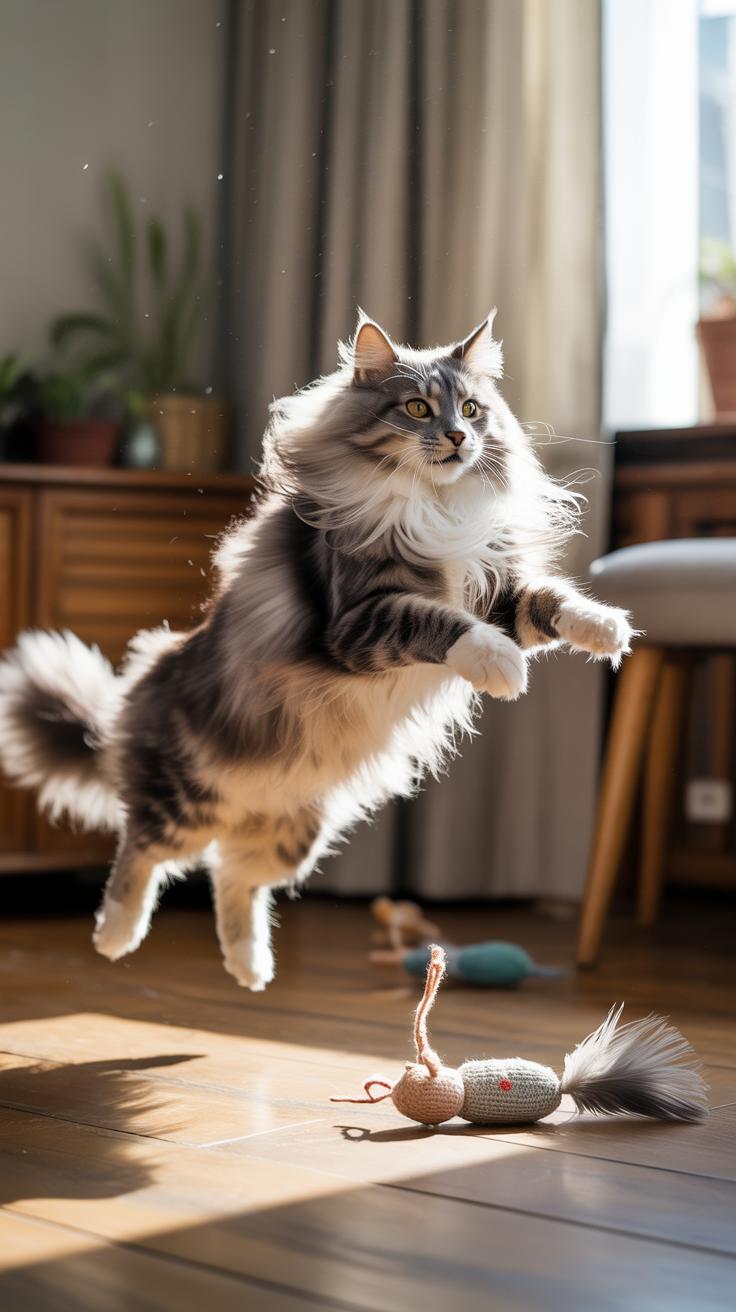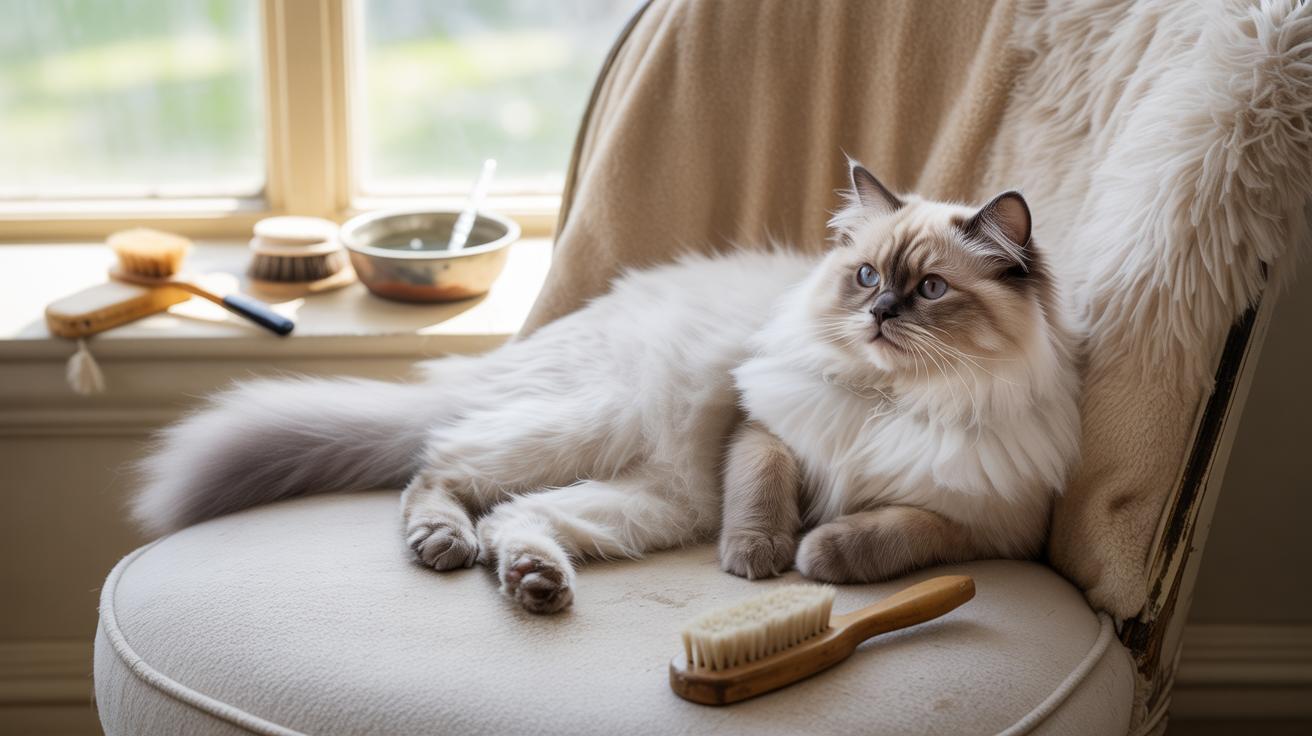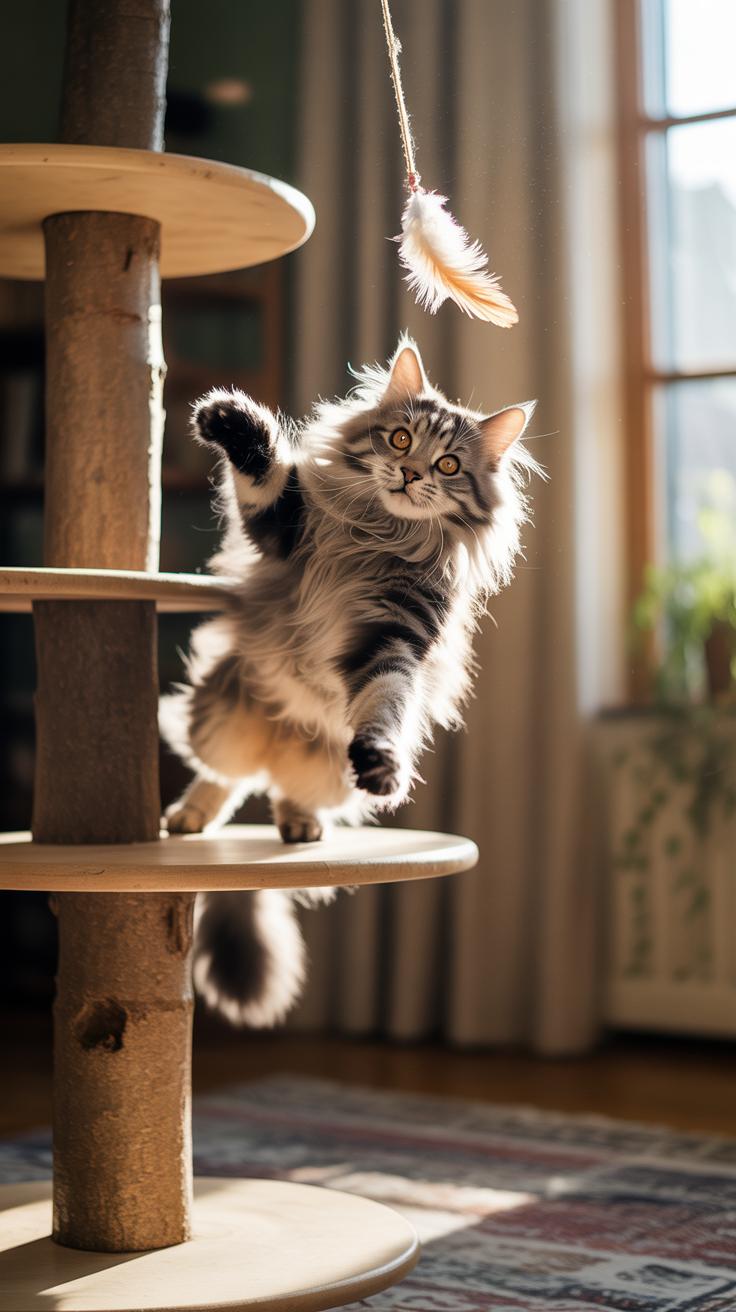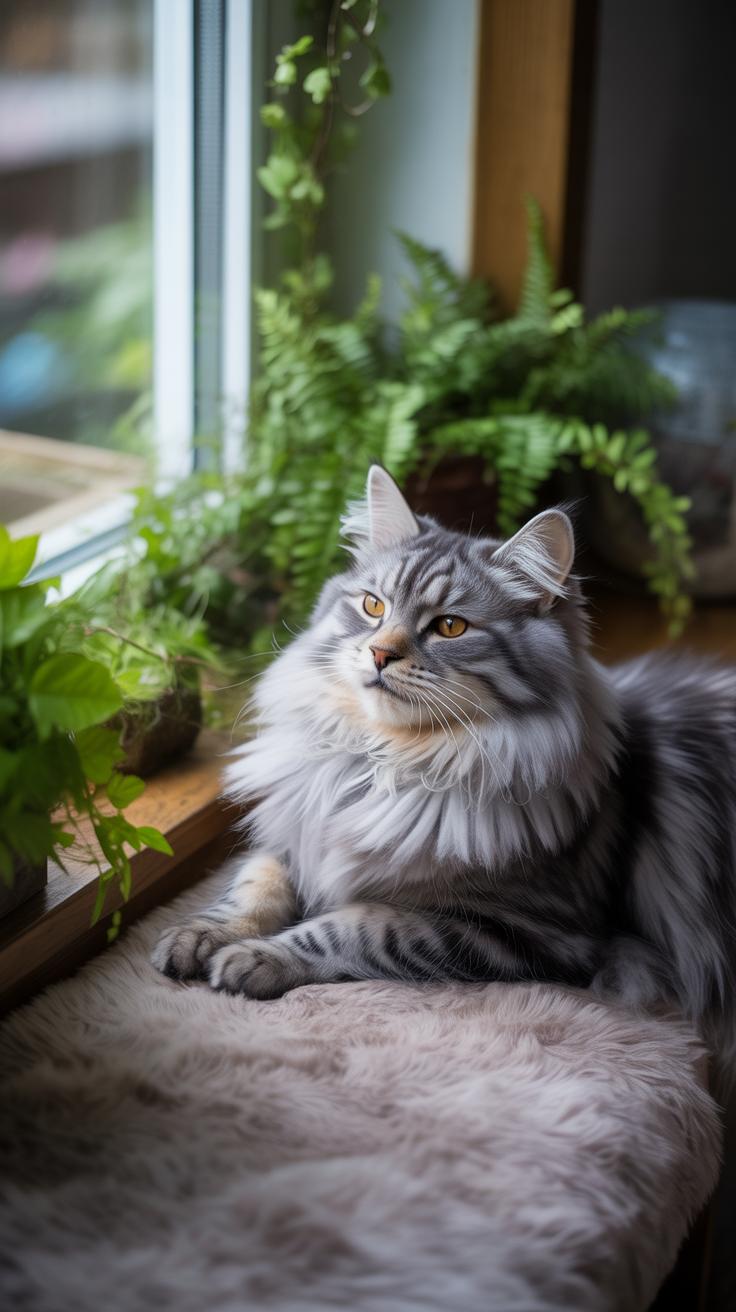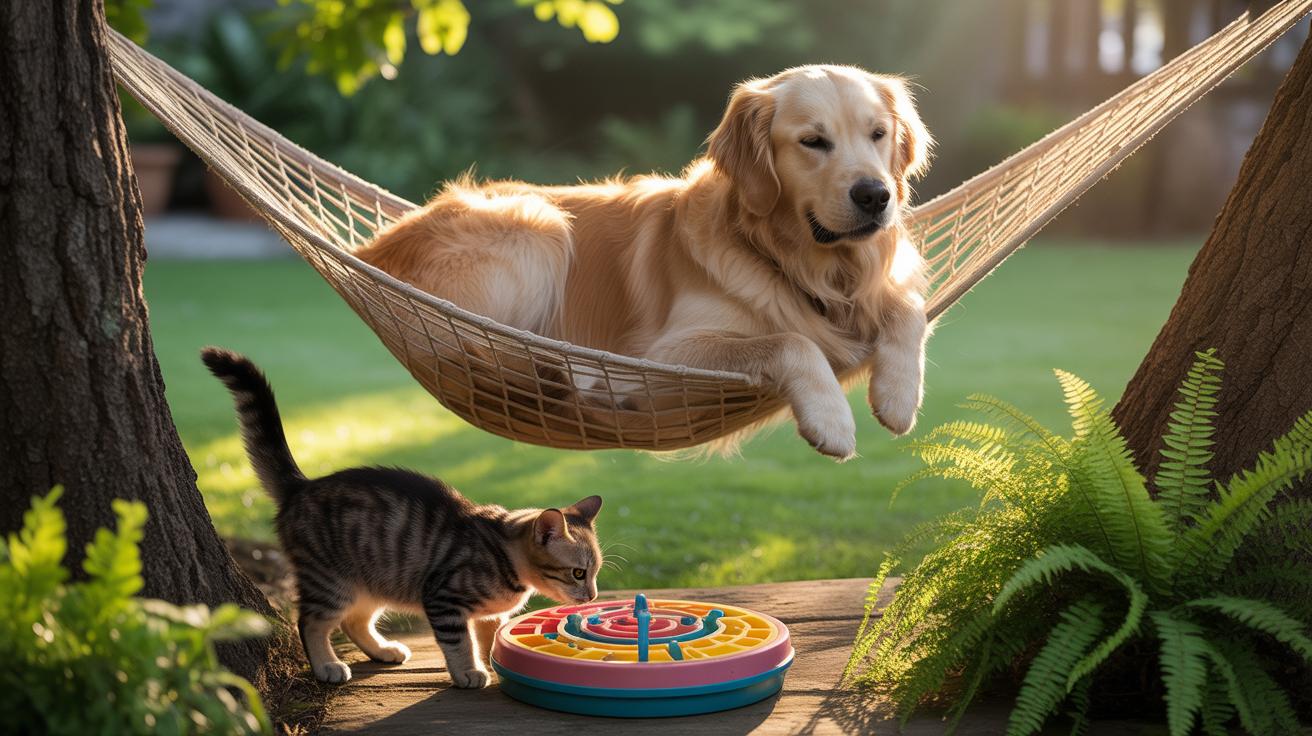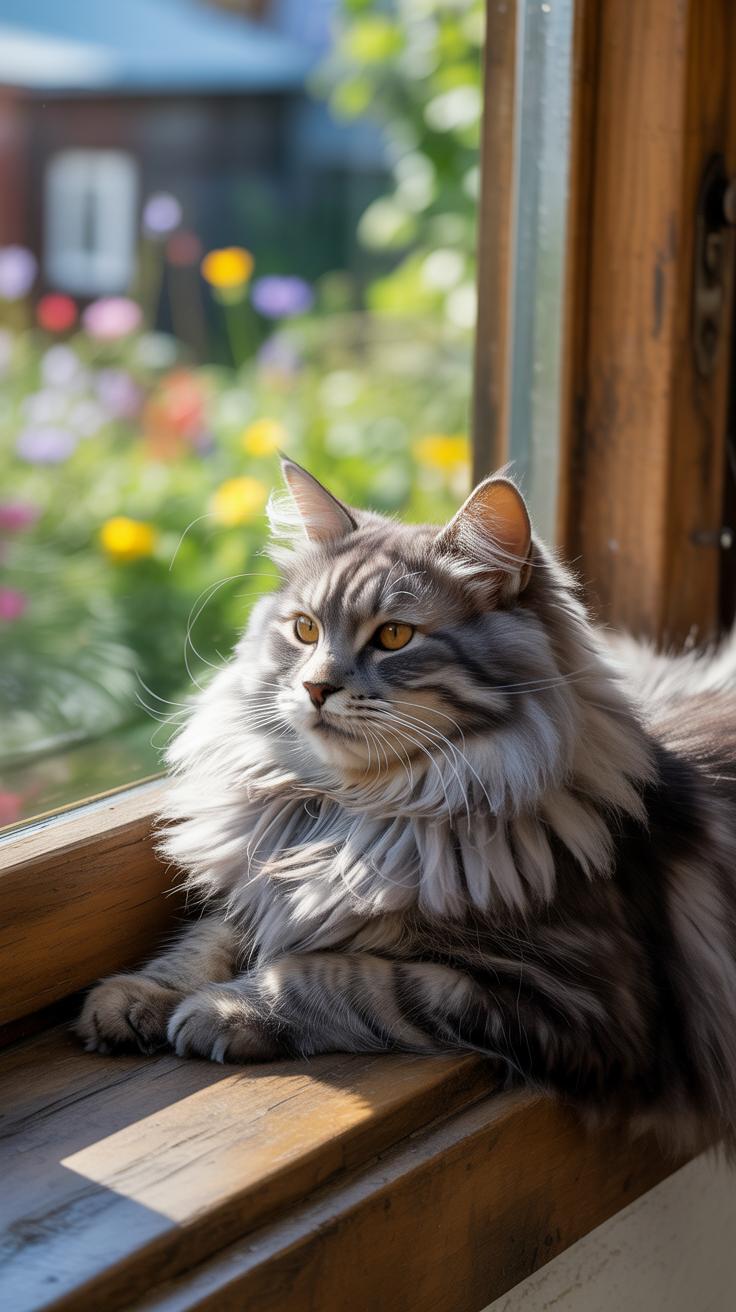Introduction
The Norwegian Forest Cat is a strong and beautiful breed. Known for its thick coat and climbing skills, it thrives in colder climates. Caring for this cat means understanding its unique needs. This guide will help you provide the best home for your Norwegian Forest Cat for a happy and healthy life.
You will learn how to feed your cat properly, care for its coat, train it, and keep it healthy. Each section explores important care areas, giving you practical advice. Whether you are a new or experienced cat owner, this guide will help you meet your pet’s needs.
Understanding the Breed
The Norwegian Forest Cat is a breed with an intriguing past that seems almost tied to the rugged landscapes of Norway. Its origins stretch back to Viking times—some say these cats accompanied the Vikings on their voyages, thriving in dense forests and harsh climates. Over the centuries, they adapted well to the cold, developing traits suited for survival in snowy environments.
Physically, these cats are quite striking. They tend to have a large, muscular build—strong but not bulky—with long legs that give them a graceful yet sturdy stance. Their bushy tail acts almost like a warm scarf, wrapping around their body when needed. Their thick double coat resists water and traps warmth, perfect for those icy Norwegian winters. You might notice how their fur still feels dense even in summer, suggesting they’re ready for a cold snap at any moment.
One trait that stands out is their climbing ability. Norwegian Forest Cats are natural climbers, often seen scaling trees or perched high on shelves if you own one. It’s almost like they’re built to be part forest ranger. This makes sense, given their ancestors needed such skills to catch prey and evade predators among Norway’s towering woods.
- Originated in Norway, often linked with Viking ships
- Adapted to survive cold, harsh winters with thick, water-resistant fur
- Strong, muscular body with long legs and a bushy tail
- Exceptional climbers, reflecting their natural forest habitat
When you think about it, this breed feels like a glimpse into history and nature—living proof of how animals can evolve alongside humans and their environments. If you have a Norwegian Forest Cat, you might find yourself marveling at its quiet confidence and ability to handle whatever you throw at it, literally and figuratively.
Feeding and Nutrition
Norwegian Forest Cats need a diet that supports their active lifestyle and sturdy build. Their muscular bodies require protein as the main ingredient in their meals. Think of quality meat sources—chicken, turkey, fish—they fuel their energy better than fillers like corn or grains do. You might find some commercial foods that claim to be good, but not all are created equal for this breed.
Balanced nutrition means including not just protein but also fats and essential nutrients like taurine, which cats can’t make themselves. You may wonder if dry or wet food is better. Some owners prefer mixing both to offer variety and keep hydration levels up. Remember, hydration is just as important since these cats evolved in colder climates but still need ample moisture.
Setting a feeding schedule is helpful. Twice a day works well for most adults, while kittens might need more frequent meals. It’s tempting to leave food out all day, but that can lead to overeating and weight gain, which you want to avoid. Offering controlled portions prevents the risk of obesity, which can sneak up without obvious signs.
If you’ve noticed your cat gaining weight despite regular activity, try measuring their food or switching to a diet formulated for less active cats. I once struggled to keep my Forest Cat’s weight stable until I adjusted portion sizes and added more playtime. The cat responded positively; that hint might help you too.
Grooming Essentials
The Norwegian Forest Cat’s thick, double coat demands regular attention to keep it healthy. This coat isn’t just for looks—it helps protect your cat from harsh weather, but it also means tangles and mats can form pretty quickly if you’re not careful.
Brushing Techniques
You should aim to brush your cat at least two to three times a week. Daily brushing is even better during shedding season to catch loose hair before it turns into a mess. Use a wide-toothed comb first to gently work through any knots, then follow with a slicker brush to remove loose hairs. Go slowly, especially around the neck and behind the ears where mats tend to start.
Sometimes your cat might resist brushing—patience helps. I found that talking softly and offering treats keeps my cat calmer. Have you tried different brush types? Some cats really prefer a soft-bristle brush, but you have to see what suits yours best.
Bathing and Skin Care
Bathing isn’t usually necessary unless your cat gets into something sticky or dirty. When you do bathe your Norwegian Forest Cat, use lukewarm water and a shampoo made for cats—human products can irritate their skin. Be gentle and thorough rinsing is key to avoid residue build-up.
Watch for dry patches on the skin; their dense fur can sometimes hide skin problems. If you notice dandruff or redness, consult your vet rather than guessing at treatments. Baths every few months or only as needed keep your cat clean without stripping natural oils. It’s a balance—too frequent bathing might dry them out, but skipping it entirely might lead to unpleasant smells or mats.
Health and Vet Care
Norwegian Forest Cats are generally hardy, but like all breeds, they face specific health concerns you should watch for. Some conditions seem more common in this breed than others, so knowing what to expect can make all the difference.
Here are a few issues to keep an eye on:
- Hypertrophic Cardiomyopathy (HCM): This heart condition can develop silently. You might notice lethargy or difficulty breathing late, but often it’s subtle at first.
- Hip Dysplasia: Though not rampant, some Forest Cats show signs of joint trouble. Stiffness or reluctance to jump could be an early hint.
- Glycogen Storage Disease: Rare but serious, it affects metabolism. Signs may include weakness or an unusual gait—better caught early.
Spotting these requires close attention to your cat’s behavior and physical condition. Changes might seem minor or even occasional, but trust your instincts to check with the vet if something feels off.
Routine Vet Visits
Keeping your Norwegian Forest Cat healthy means staying ahead with regular vet visits. Annual checkups let your vet catch any subtle health shifts you might miss. I’ve noticed that when owners skip these, small issues sometimes grow unnoticed.
Vaccinations aren’t just a box to tick. They protect your cat from contagious diseases that can be harsh on any cat, including your Forest Cat. Keeping vaccines up to date also means avoiding unexpected vet trips later for preventable illnesses.
Preventative care goes beyond shots—regular dental checks, parasite control, and weight monitoring play big roles too. Sometimes, I wonder if people underestimate how much routine care keeps their cats feeling their best in the long run.
If you’re unsure about any part of your cat’s health, don’t hesitate to ask your vet. Building a relationship with them helps create a safety net for your furry friend over the years.
Exercise and Play
Norwegian Forest Cats are built for movement—they have strong muscles and love to climb, but sometimes they’ll act a bit lazy, especially indoors. Keeping them active isn’t just about running around; mental engagement matters just as much. You might notice your cat stalking toys or leaping for feathers with surprising agility, which taps into their natural hunting instincts.
Games that mimic hunting work well. Wand toys with feathers or small dangling objects can trigger their pounce reflex. Puzzle feeders can keep them thinking while working for treats. Climbing structures—like tall cat trees or shelves—appeal to their love of heights and satisfy their need to explore vertical space.
To encourage exercise, try short, frequent play sessions rather than long marathons. Sometimes a quick chase or a few minutes of jumping are enough to keep their interest. Changing toys around or adding new textures can spark curiosity. You might find that your cat prefers acting like an ambush predator rather than chasing continuously, so watch and adapt your play style accordingly.
Have you noticed whenever you shake a crinkly ball or toss a light toy, your Norwegian Forest Cat perks up immediately? That’s a good reminder—sometimes simple changes make a big difference in getting them moving.
Training Your Cat
Training a Norwegian Forest Cat can feel a bit different from other breeds. These cats are smart but sometimes a bit independent—so patience really helps. Using positive reinforcement works best. That means rewarding good behavior with treats, gentle praise, or a favorite toy instead of punishment, which often just confuses them.
Basic Commands
Simple commands like “come,” “sit,” or even “high five” are doable. Start by choosing a quiet spot and use a clear, calm voice. For example, say “come” and show a treat; when your cat approaches, reward immediately. You’ll want to keep sessions brief and upbeat—around five minutes—otherwise, they may just lose interest.
Don’t expect perfect consistency at first—it sometimes feels like training a toddler. But with time, your cat can learn to respond reliably. Just remember to be gentle and patient; harsh tones often backfire.
Litter and Behavior
Most Norwegian Forest Cats catch on to litter boxes quickly if the box is clean and in a quiet, accessible spot. Scoop daily and keep the box in a low-traffic area. If your cat avoids the box, check for any illness or stress triggers—it could be as simple as a dirty box or too much noise nearby.
Behavior issues like scratching furniture or nighttime activity often arise. Redirect scratching to a sturdy post by rewarding your cat when they use it. For nighttime restlessness, a tired cat plays better during the day, so keep up with active play routines.
Sometimes, you’ll wonder if they truly listen or just humor you. But with steady, positive guidance, they usually surprise you. The trick is consistency—small rewards, clear commands, and loads of patience. Have you noticed your Norwegian Forest Cat doing clever tricks yet?
Creating a Safe Home
Indoor Living Setup
Norwegian Forest Cats love to climb, so setting up tall scratching posts or climbing trees indoors really helps. Think about using shelves or wall-mounted perches too—this breed enjoys high vantage points. Cozy nooks or soft beds near windows often become their favorite spots. You might notice yours retreating there during quiet moments. Safe toys that encourage activity, like feather wands or puzzle feeders, add variety without overwhelming them.
It’s easy to overlook smaller details. For example, keeping cords and small objects out of reach can prevent mishaps—they’re curious and sometimes swipe at things unexpectedly. I remember a friend who had to cat-proof her whole living room after her cat’s curious paw got tangled in a blind cord.
Outdoor Safety
Letting your Norwegian Forest Cat outside can feel tempting—they’re sturdy with thick fur built for cold, but the outdoors holds risks. Cars, predators, or toxins all present dangers. If you decide on outside time, consider controlled access like enclosed patios or “catios.” They let your cat explore without real risks.
Some owners trust their cats off-leash, but that always carries some uncertainty. Is your cat prone to wander or stay close to home? Collars with ID tags and microchips help if your cat slips out. Ultimately, weighing the freedom your cat wants against possible threats can be tricky. Yet, many Norwegian Forest Cats adapt well to indoor life when their environment feels rich enough.
Building a Strong Bond
Socializing Your Cat
Norwegian Forest Cats can be cautious at first, so helping them adjust gently to new people and pets makes a big difference. Start by introducing your cat to visitors slowly, maybe letting them sit quietly and offer a hand for sniffing rather than rushing into petting. New faces can feel overwhelming, so giving your cat space to retreat if needed usually keeps things calm.
Pets in the house require patience. Let your cat observe from a distance before any close encounters. A few brief, positive experiences build confidence over time. You might notice your cat hiding at first, but with steady exposure—maybe short play sessions near the newcomer—they often learn to share the same space without stress.
Remember, socializing isn’t a race. Some cats take weeks or even months to warm up, and that’s okay. Offering treats and gentle reassurance during these moments helps your Norwegian Forest Cat associate people and other animals with safety and comfort.
Reading Cat Behavior
Understanding your cat’s mood can be tricky—those subtle changes in tail movement or ear position might mean something you don’t expect at first. For example, a Norwegian Forest Cat flicking its tail isn’t always annoyed; sometimes it’s just focused. Watch for slow blinking too—that’s often a sign they trust you or feel relaxed.
Being aware of these signals improves your relationship because you avoid pushing your cat beyond comfort. If the cat flattens ears or tucks the tail, it’s better to give space rather than insist on affection. Sometimes, their body might say “not now,” even when they’re curious.
Try observing quietly before interacting and see what your cat enjoys. Does it prefer gentle stroking around the cheeks or a playful game with feathery toys? This quiet attention helps build trust—and that’s the real foundation for affection with your Norwegian Forest Cat.
Conclusions
Taking care of a Norwegian Forest Cat involves feeding it well, grooming regularly, and ensuring it stays healthy. Its thick fur needs special attention to prevent matting. Regular play and exercise keep the cat active and happy. Knowing how to spot health issues early can prevent problems later.
With the right care, your Norwegian Forest Cat will stay strong and loving. This breed enjoys interaction and activity, so your time together will build a strong bond. Keep learning about your cat’s needs, and you will enjoy many years of companionship.

